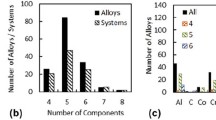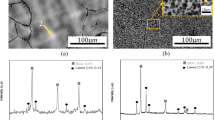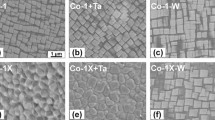Abstract
As part of round robin testing, specimens of commercial alloys 316, 120, 625, and 740 were exposed to 20 MPa research grade CO2 at 700 °C for up to 1500 h. The first set of specimens had higher mass gain likely due to impurities not flushed from the autoclave at startup. After this issue was corrected, an identical set of specimens exhibited lower mass gains for both the Fe- and Ni-based alloys. The differences in reaction products were characterized to understand the effect of impurities under these conditions. As suggested by the mass change, thicker oxides were formed in each case, primarily for the Fe-based alloys. For the Ni-based alloys, the difference was primarily in the transient stage of oxidation with no change in rate constant. Alloy 120 exhibited increased internal attack, and differences in the scale phases formed were characterized to better understand the effect of impurities. Alloy 740 primarily exhibited a greater depth of internal attack in the first run.
















Similar content being viewed by others
References
B. J. P. Buhre, L. K. Elliott, C. D. Sheng, R. P. Gupta and T. F. Wall, Oxy-fuel combustion technology for coal-fired power generation. Progress in Energy and Combustion Science31, 283 (2005).
V. Dostal, P. Hejzlar and M. J. Driscoll, High-performance supercritical carbon dioxide cycle for next-generation nuclear reactors. Nuclear Technology154, 265 (2006).
B. D. Iverson, T. M. Conboy, J. J. Pasch and A. M. Kruizenga, Supercritical CO2 brayton cycles for solar-thermal energy. Applied Energy111, 957 (2013).
R. J. Allam, M. R. Palmer, G. W. Brown Jr., J. Fetvedt, D. Freed, H. Nomoto, M. Itoh, N. Okita and C. Jones Jr., High efficiency and low cost of electricity generation from fossil fuels while eliminating atmospheric emissions, including carbon dioxide. Energy Procedia37, 1135 (2013).
E. G. Feher, The supercritical thermodynamic power cycle. Energy Conversion8, 85 (1968).
M. W. Dunlevy, An Exploration of the Effect of Temperature on Different Alloys in Supercritical Carbon Dioxide Environment, M.Sc. Thesis. (MIT, Cambridge, MA, 2009).
V. Firouzdor, K. Sridharan, G. Cao, M. Anderson and T. R. Allen, Corrosion of a stainless steel and nickel-based alloys in high temperature supercritical carbon dioxide environment. Corrosion Science69, 281 (2013).
B. A. Pint and J. R. Keiser, Initial assessment of Ni-base alloy performance in 0.1 MPa and supercritical CO2. JOM67, 2615 (2015).
R. I. Olivares, D. J. Young, P. Marvig and W. Stein, Alloys SS316 and Hastelloy-C276 in supercritical CO2 at high temperature. Oxidation of Metals84, 585 (2015).
J. Mahaffey, D. Adam, A. Brittan, M. Anderson and K. Sridharan, Corrosion of alloy Haynes 230 in high temperature supercritical carbon dioxide with oxygen impurity additions. Oxidation of Metals86, 567 (2016).
B. A. Pint, R. G. Brese and J. R. Keiser, Effect of pressure on supercritical CO2 compatibility of structural alloys at 750°C. Materials and Corrosion68, 151 (2017).
J. Mahaffey, A. Schroeder, D. Adam, A. Brittan, M. Anderson, A. Couet and K. Sridharan, Effects of CO and O2 impurities on supercritical CO2 corrosion of alloy 625. Metallurgical and Materials Transactions A49, 3703 (2018).
S. C. Kung, J. P. Shingledecker, I. G. Wright, A. S. Sabau, B. M. Tossey, and T. Lolla, Corrosion of Heat Exchanger Alloys in Open-Fired sCO2 Power Cycles, in Proceedings of the 6th International Symposium on Supercritical CO2Power Cycles, Pittsburgh, PA, March 2018, Paper #5.
B. A. Pint, J. Lehmusto, M. J. Lance and J. R. Keiser, The effect of pressure and impurities on oxidation in supercritical CO2. Materials and Corrosion70, 1400 (2019).
J. D. Tucker, B. Adam, M. Anderson, B. Pint, G. R. Holcomb, C. S. Carney, H. Saari, L. Teeter, J. Mahaffey, Ö. Doğan, C. Jang, S. Kung, Supercritical CO2 round robin test program, in The 6th International Supercritical CO2Power Cycles Symposium, 2018, Pittsburgh, PA, USA Paper #146.
M. J. Lance, D. N. Leonard and B. A. Pint, The use of glow discharge optical emission spectroscopy to quantify internal carburization in supercritical CO2, in The 6th International Supercritical CO2Power Cycles Symposium, 2018, Pittsburgh, PA, USA. Paper #117.
B. A. Pint, R. G. Brese and J. R. Keiser, Supercritical CO2 Compatibility of Structural Alloys at 400°-750°C, NACE Paper C2016-7747, Houston, TX, Presented at NACE Corrosion 2016, Vancouver, Canada, March 2016.
B. A. Pint, K. A. Unocic, R. G. Brese and J. R. Keiser, Characterization of chromia scales formed in supercritical carbon dioxide. Materials at High Temperature35, 39 (2018).
B. Pieraggi, Calculations of parabolic reaction rate constants. Oxidation of Metals27, 177 (1987).
C. T. Fujii and R. A. Meussner, The mechanism of the high-temperature oxidation of iron-chromium alloys in water vapor. Journal of the Electrochemical Society111, 1215 (1964).
G. C. Wood, I. G. Wright, T. Hodgkiess and D. P. Whittle, A comparison of the oxidation of Fe-Cr, Ni-Cr and Co-Cr alloys in oxygen and water vapor. Materials and Corrosion21, 900 (1970).
M. R. Taylor, J. M. Calvert, D. G. Lees and D. B. Meadowcroft, The mechanism of corrosion of Fe-9%Cr alloys in carbon dioxide. Oxidation of Metals14, 499 (1980).
H. E. Evans and R. C. Lobb, Alloy depletion profiles during non-protective oxidation. Corrosion Science24, 223 (1984).
J. Zurek, M. Michalik, F. Schmitz, T. U. Kern, L. Singheiser and W. J. Quadakkers, The effect of water-vapor content and gas flow rate on the oxidation mechanism of a 10%Cr-ferritic steel in Ar-H2O mixtures. Oxidation of Metals63, 401 (2005).
G. Cao, V. Firouzdor, K. Sridharan, M. Anderson and T. R. Allen, Corrosion of austenitic alloys in high temperature supercritical carbon dioxide. Corrosion Science60, 246 (2012).
Y. Gong, D. J. Young, P. Kontis, Y. L. Chiu, H. Larsson, A. Shin, J. M. Pearson, M. P. Moody and R. C. Reed, On the breakaway oxidation of Fe9Cr1Mo steel in high pressure CO2. Acta Materialia130, 361 (2017).
N. Otsuka, Y. Shida and H. Fujikawa, Internal-external transition for the oxidation of Fe-Cr-Ni austenitic stainless steels in steam. Oxidation of Metals32, 13 (1989).
R. Peraldi and B. A. Pint, Effect of Cr and Ni contents on the oxidation behavior of ferritic and austenitic model alloys in air with water vapor. Oxidation of Metals61, 463 (2004).
G. H. Meier, K. Jung, N. Mu, N. M. Yanar, F. S. Pettit, J. Pirón Abellán, T. Olszewski, L. Nieto Hierro, W. J. Quadakkers and G. R. Holcomb, Effect of alloy composition and exposure conditions on the selective oxidation behavior of ferritic Fe–Cr and Fe–Cr–X alloys, Oxidation of Metals74, 319 (2010).
W. J. Quadakkers, T. Olszewski, J. Piron-Abellan, V. Shemet, L. Singheiser Oxidation of metallic materials in simulated CO2/H2O-rich service environments relevant to an oxyfuel plant, Materials Science Forum696, 194 (2011).
S. Bouhieda, F. Rouillard and K. Wolski, Influence of CO2 purity on the oxidation of a 12Cr ferritic-martensitic steel at 550 degrees C and importance of the initial stage. Materials at High Temperature29, 151 (2012).
T. Gheno, D. Monceau and D. J. Young, Kinetics of breakaway oxidation of Fe-Cr and Fe-Cr-Ni alloys in dry and wet carbon dioxide. Corrosion Science77, 246 (2013).
B. A. Pint and J. K. Thomson, Effect of oxy-firing on corrosion rates at 600°-650°C. Materials and Corrosion65, 132 (2014).
T. D. Nguyen, J. Q. Zhang and D. J. Young, Growth of Cr2O3 blades during alloy scaling in wet CO2 gas. Corrosion Science133, 432 (2018).
R. P. Oleksak, J. H. Tylczak, C. S. Carney, G. R. Holcomb and O. N. Dogan, High-temperature oxidation of commercial alloys in supercritical CO2 and related power cycle environments. JOM70, 1527 (2018).
T. D. Nguyen, A. La Fontaine, L. Yang, J. M. Cairney, J. Zhang and D. J. Young, Atom probe study of impurity segregation at grain boundaries in chromia scales grown in CO2 gas. Corrosion Science132, 125 (2018).
G. R. Holcomb, Steam oxidation and chromia evaporation in ultrasupercritical steam boilers and turbines. Journal of the Electrochemical Society156, C292 (2009).
C. Wells, W. Batz, R. F. Mehl, Diffusion coefficient of carbon in austenite, Transactions of the American Institute of Mining and Metallurgical Engineers188, 553–560 (1950).
Z. Tökei, K. Hennesen, H. Viefhaus and H. J. Grabke, Diffusion of chromium in ferritic and austenitic 9–20 Wt% chromium steels, Materials Science Technology16, 1129 (2000).
S. R. J. Saunders, M. Monteiro and F. Rizzo, The oxidation behavior of metals and alloys at high temperatures in atmospheres containing water vapour: a review. Progress in Materials Science53, 775 (2008).
C. W. Tuck, M. Odgers and K. Sachs, The oxidation of iron at 950°C in oxygen/water vapour mixtures. Corrosion Science9, 281 (1969).
G. Bamba, Y. Wouters, A. Galerie G. Borchardt, S. Shimada, O. Heintz, S. Chevalier, Inverse growth transport in thermal chromia scales on Fe-15Cr steels in oxygen and in water vapor and its effect on scale adhesion, Scripta Materialia57, 671 (2007).
L. Couture, F. Ropital, F. Grosjean, J. Kittel, V. Parry and Y. Wouters, Reversible catastrophic oxidation of a 38Fe–34Ni–25Cr alloy induced by sodium sulphate at low oxygen potential atmospheres. Corrosion Science55, 133 (2012).
B. A. Pint and K. A. Unocic, Evaluation of Fe-Cr alloys for accident tolerant fuel cladding, Oxidation of Metals87, 515 (2017).
C. M. Chun, S. Desai, F. Hershkowitz and T. A. Ramanarayanan, Materials challenges in cyclic carburizing and oxidizing environments for petrochemical applications. Materials and Corrosion65, 282 (2014).
B. Gleeson and M. A. Harper, The long-term, cyclic-oxidation behavior of selected chromia-forming alloy. Oxidation of Metals49, 373 (1998).
A. H. Rosenstein, J. K. Tien and W. D. Nix, Void formation in INCONEL MA-754 by high temperature oxidation. Metallurgical Transactions A17, 151 (1986).
R. H. Bricknell and D. A. Woodford, The mechanism of cavity formation during high temperature oxidation of nickel. Acta Metallurgica30, 257 (1982).
B. Adam, L. Teeter, J. Mahaffey, M. Anderson, L. Árnadóttir and J. D. Tucker, Effects of corrosion in supercritical CO2 on the microstructural evolution in 800H alloy. Oxidation of Metals90, 453 (2018).
B. Li and B. Gleeson, Effects of silicon on the oxidation behavior of Ni-base chromia-forming alloys. Oxidation of Metals65, 101 (2006).
B. Jönsson and C. Svedberg, Limiting factors for Fe-Cr-Al and NiCr in controlled industrial atmospheres. Materials Science Forum251–254, 551 (1997).
I. E. McCarroll, A. La Fontaine, T. D. Nguyen, A. F. Smith, J. Zhang, D. J. Young and J. M. Cairney, Performance of an FeCrAl alloy in a high-temperature CO2 environment. Corrosion Science139, 267 (2018).
Acknowledgements
This work has been carried out within the Academy of Finland project “Novel Approaches to Study Corrosion Mechanisms in High-temperature Industrial Processes” (Decision no. 296435). The research was funded by the U.S. Department of Energy, Office of Fossil Energy, Crosscutting Technology Program and the Office of Nuclear Energy, Nuclear Energy University Program led by J. Tucker at Oregon State Univ. The authors would like to thank M. Howell, M. Stephens, T. M. Lowe and T. Jordan for assistance with the experimental work. Specimens were all provided and prepared by S. C. Kung at EPRI for the round robin experiment. J. Jun and R. Pillai provided helpful comments on the manuscript.
Author information
Authors and Affiliations
Corresponding author
Additional information
Publisher's Note
Springer Nature remains neutral with regard to jurisdictional claims in published maps and institutional affiliations.
Rights and permissions
About this article
Cite this article
Lehmusto, J., Kurley, J.M., Lance, M.J. et al. The Impact of Impurities on Alloy Behavior in Supercritical CO2 at 700 °C. Oxid Met 94, 95–111 (2020). https://doi.org/10.1007/s11085-020-09980-9
Received:
Revised:
Published:
Issue Date:
DOI: https://doi.org/10.1007/s11085-020-09980-9




